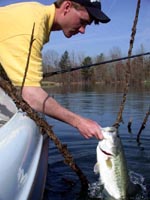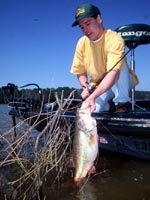
|
Features
|
|
|
|
Books
|
|
|
|
Fun & Games
|
|
|
|
Contact Us
|
|
|
John's Journal... Entry 197, Day 4
KEN COOK ON BASS FISHING
Ken Cook's Crankbait Strategy
 EDITOR'S
NOTE: Ken Cook of Meers, Oklahoma, a professional
bass fisherman since 1983, and before that a fisheries biologist, won
the BASS Masters Classic in 1991, as well as other B.A.S.S. events.
EDITOR'S
NOTE: Ken Cook of Meers, Oklahoma, a professional
bass fisherman since 1983, and before that a fisheries biologist, won
the BASS Masters Classic in 1991, as well as other B.A.S.S. events.
Question: Ken, what's another rod you like to use?
Answer: I designed a crankbait rod, a 7-foot one-piece medium-action rod.
You won't find this graphite, parabolic-bend rod very heavy. You need
to have a lot of bend in a crankbait rod to give the bass a better chance
of inhaling the bait and your landing the fish. Many anglers like fiberglass,
but I prefer to fish for bass with graphite.
 Question:
Most people say graphite is too stiff for fishing a crankbait and doesn't
give the fish the bait. What makes your rod different?
Question:
Most people say graphite is too stiff for fishing a crankbait and doesn't
give the fish the bait. What makes your rod different?
Answer: Actually that's an untrue statement. Graphite will give the fish
the bait. I prefer more sensitivity in my rod because then I know what
the bait's doing, and I can tell what type of bottom I'm fishing. I like
to feel every wiggle my crankbait makes. I think sensitivity in a rod
allows you to hook more fish.
Question: How do you prevent tearing the hook out of
the fish's mouth?
Answer: This medium-action rod, a soft-action rod, has a parabolic bend
all the way down to the butt, which equals a lot of give. The flex of
the rod is what prevents you from tearing the hook out of the fish's mouth.
I'm convinced a fisherman isn't fast enough to feel a bass and jerk the
bait away. I just think a graphite rod works better.
 I
don't have a problem losing or missing fish with a graphite rod, and I
find a graphite rod lighter, more sensitive and a lot easier to fish with
than a fiberglass rod. I'll take that rod and tie on a crankbait that
fits the fishing situation. I may use a crankbait that runs a foot deep
or one that runs 15 feet deep to fish the cover where I think the bass
are living. I want that crankbait to hit the bottom and the cover and
bounce around that underwater area.
I
don't have a problem losing or missing fish with a graphite rod, and I
find a graphite rod lighter, more sensitive and a lot easier to fish with
than a fiberglass rod. I'll take that rod and tie on a crankbait that
fits the fishing situation. I may use a crankbait that runs a foot deep
or one that runs 15 feet deep to fish the cover where I think the bass
are living. I want that crankbait to hit the bottom and the cover and
bounce around that underwater area.
Question: Most people cast a crankbait and wind it in,
but you don't. What are you doing that's different?
Answer: The key to fishing a crankbait successfully is to use a crankbait
that runs in the depth you're trying to fish. If you're fishing an 8-foot
drop-off, you need to fish a 10-foot-deep crankbait to make sure it gets
to the bottom. You want the bait to hit the bottom, bounce around and
roll around in the cover. Even though the bait may hang up somewhat and
deflect off the side when it hits cover, many times those erratic motions
are what trigger strikes.
 Question:
One problem most people have with the crankbait is they tend to get crankbaits
hung up. What are you doing to keep your crankbait from getting hung?
Question:
One problem most people have with the crankbait is they tend to get crankbaits
hung up. What are you doing to keep your crankbait from getting hung?
Answer: That's why I like a sensitive rod because then I can feel when
my bait is bouncing along the cover. If my line comes in contact with
a stump, a limb or whatever, I can feel it with a graphite rod. You can't
feel these things as well with fiberglass. So I know I can stop or slow
down my retrieve and feel the bait as I pull it up to the stump or other
object. I can finesse it over the cover better because I can tell what
the bait is doing. Fiberglass usually doesn't give an angler that option.
And since fiberglass isn't as sensitive, you don't know what the bait
is doing. That's one of the advantages of graphite. You get to feel the
bait as it works through the cover, and the lip of the bait usually will
deflect off if you don't jerk it. You have to feel it as it works through
the cover.
TOMORROW: KEN COOK'S DOODLING WORM TECHNIQUE
Check back each day this week for more about KEN COOK ON BASS FISHING ...
Day 1 - Swimming-Worm Technique
Day 2 - Ken Cook's Spinner Bait Tactic
Day 3 - Ken Cook's Jerkbait Method
Day 4 - Ken Cook's Crankbait Strategy
Day 5 - Ken Cook's Doodling Worm Technique